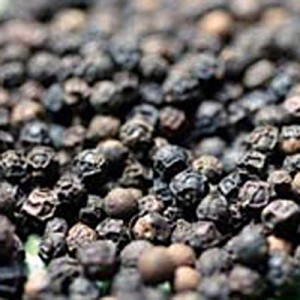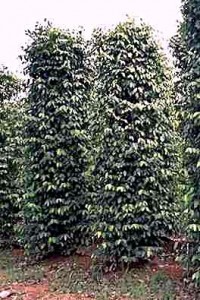 Black pepper (Piper nigrum) is a flowering vine in the family Piperaceae, cultivated for its fruit, which is usually dried and used as a spice and seasoning. The fruit, known as a peppercorn when dried, is a small drupe approximately 5 millimetres (0.20 in) in diameter, dark red when fully mature, containing a single seed. Black pepper is native to South India and is extensively cultivated there and elsewhere in tropical regions. Black pepper is a spice or seasoning common in many cuisines. The spiciness of black pepper is due to the chemical piperine. Black pepper is usually ground for use in foods.
Black pepper (Piper nigrum) is a flowering vine in the family Piperaceae, cultivated for its fruit, which is usually dried and used as a spice and seasoning. The fruit, known as a peppercorn when dried, is a small drupe approximately 5 millimetres (0.20 in) in diameter, dark red when fully mature, containing a single seed. Black pepper is native to South India and is extensively cultivated there and elsewhere in tropical regions. Black pepper is a spice or seasoning common in many cuisines. The spiciness of black pepper is due to the chemical piperine. Black pepper is usually ground for use in foods.
Planting pepper is a lifetime livelihood if well developed. If the soil is good and care is good, the quality of the harvest is likewise good and so commands a good price in the market. When harvest is poor, even the stems of this plant, when dried, can also be used and sold including the chaff when powdered.
Although these are not so strong in taste as the fruit itself, they are nevertheless sought because of the aroma they give to the food. So, even the powdered pulp gets sold.
Production of Black Pepper
Planting
1. Plant materials in pepper consist of the stem with 3 nodes. Separate these from the mother plant at the beginning of the rainy season, and plant in the nursery side by side for growing roots in a rooting bed.
2. The bed for growing these must be in the shade and elevated, surrounded by hollow blocks.
3. Make the bed three layers of soil so as to ensure good drainage such as:
- river sand on top — 1 foot thick
- small pebbles in the second layer
- bigger stones at the bottom
4. Water a little — once in the morning and one in the afternoon. Cover with a plastic sheet.
5. In one month, roots will grow about an inch at the nodes.
6. This can now be transferred to plastic bags with holes at the bottom, half filled with sand and the other half with loose soil. When transplanting, thrust a stick into the plastic bag, and in its hole, put in the plant.
7. In 2-3 months when there are about 4-5 new growths (shoots) in the upper part of the plant, it can now be transferred in the fields.
8. Black pepper is a climbing plant, so it needs a trellis or tree to climb. The best is the madre cacao (kakawate). Its long branches are cut like poles and thrust into the ground, 2-3 m apart, in April and May. These branches will grow leaves and branches in the first rain in June. Change the branch that does not grow.
9. Plant two seedlings of pepper at the base of every pole. Remove them from the plastic bag and plant one feet away from the kakawate pole. Tie the stem to the pole to help it climb. In one week, the roots of the pepper will adhere to the pole and the plant will climb by itself.
Maintenance/Care of the Pepper Plant
1. Always remove weeds around the plant. Apply fertilizer about 2 ft. away from the plant; it is much better if this is mixed with the soil. Put the fertilizer at the beginning of the rains in June: 1 kilo of 14-14-14 or 16-16-16, and ½ kilo in October. Without chemical fertilizer, the proper grains will not grow big and heavy. (See section on improvement/maintenance of plants).
2. Always prune the branches of the kakawate to allow sufficient sunshine on the pepper plant (but not so much pruning as to destroy the tree).
It is in the rainy season that pruning should be done after when the branches and leaves grow fast. Pruning is done about 5-6 times a year, or every 1-1/2 months during the rainy season. Control also the height of the kakawate (madre de cacao) because it is difficult to harvest pepper from a very high post, which should not be beyond 10 feet.
In Indonesia and Malaysia, they use posts made from strong wood that are treated against termites to make them last long. In this way, no pruning will be necessary.
Pests and Diseases of the Pepper
Two plant diseases afflict pepper, usually those whose soil has poor drainage. Pepper does not like soil that retains water, and may be the cause of its death. Other than these, pepper is resistant to pests and diseases, so pesticides are not necessary.

Harvesting
In 2 years, pepper bears fruit. Its fist fruits are not so plentiful, but in its 3rd year, harvest ranges from ½ to one kilo per tree. On its 4th year, each plant can give one to one and a half kilo dried pepper.
1. The bunches of grains are harvested when these turn yellow. They do not ripen at the same time. It takes 3 weeks to one month to harvest them.
2. The harvested pepper is spread on cement to dry like palay or coffee. In good weather, this dries in 3 days. In rainy weather, this can be left alone even up to 5 days, but let it dry by itself when the rain stops. It will be worse to gather them and put them in a container where the grains will heat up, which hastens its rot.
3. Threshing – To separate the pulp and foreign matters from the grains, it is better to use a machine for the purpose because the machine does faster work with less cost for labor.
4. Winnowing is done normally in which the immature grain and light ones separate from the matured. In this way, high quality grains are segregated, which command a higher price. As mentioned earlier, even its chaff and stems, when powdered, are commerciable.
Source: elgu2.ncc.gov; Photos: bloomdryfuits.com and pharm1.pharmazie.uni-greifswald.de